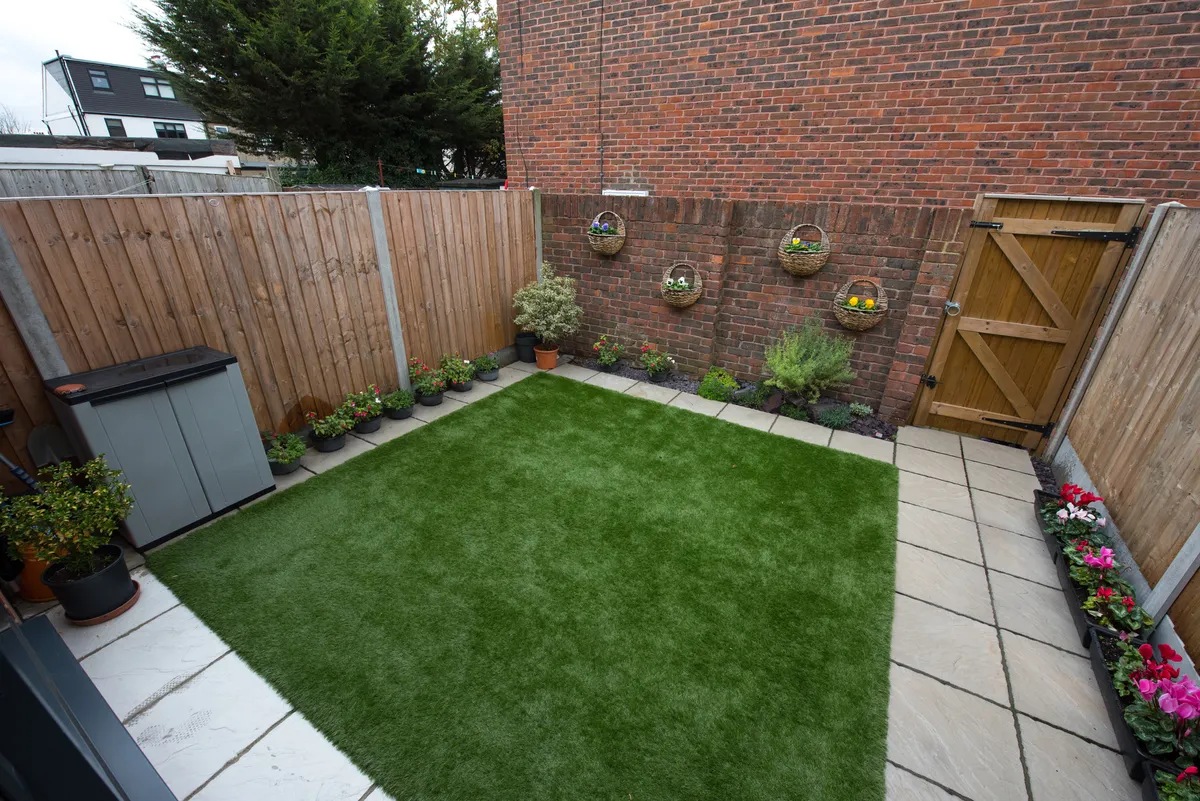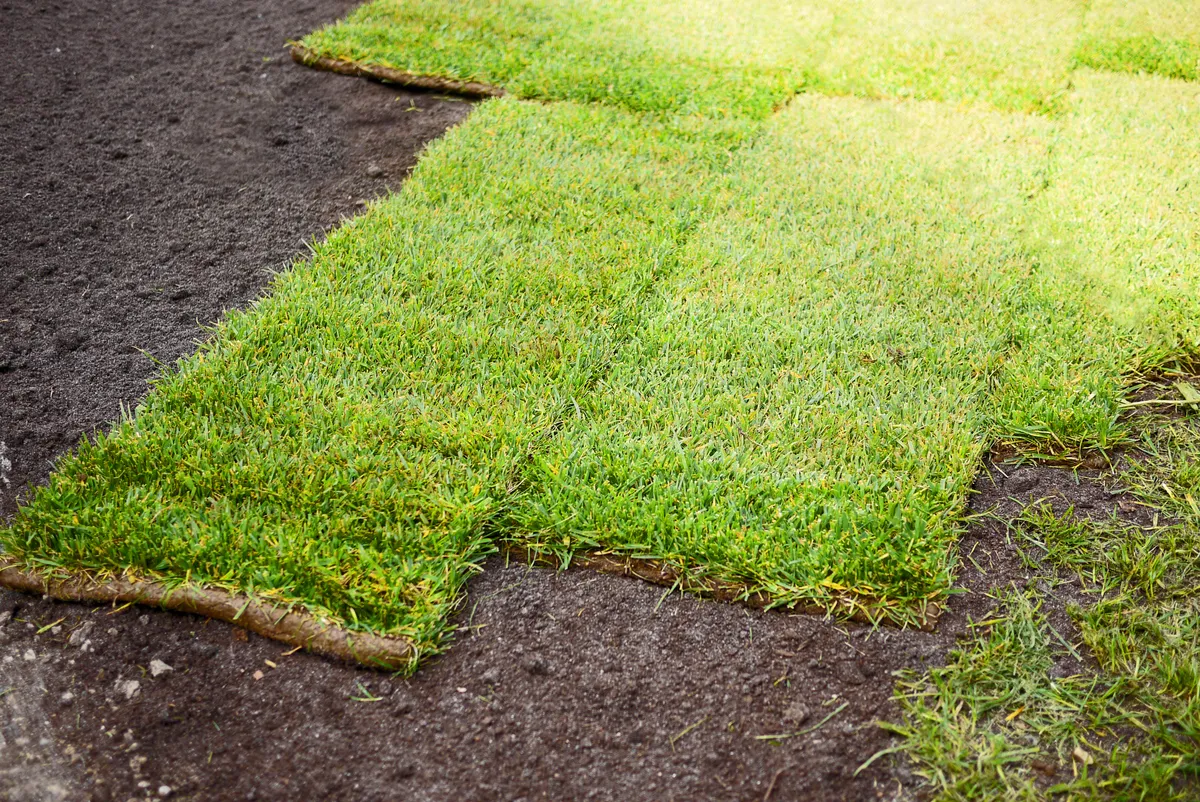Originally marketed as a way to enjoy a lush green 'lawn' in arid climates, artificial grass has taken off rapidly in the UK in recent years, becoming a more and more common choice for gardens.
However, for all its conveniences - it's durable, cheap, long-lasting, and requires almost zero maintenance - artificial grass is no friend to the environment.
Not only does the mass manufacturing of plastic grass have a negative impact on the planet, artificial grass is often used to replace real lawn, hedges or flower beds which provide valuable habitats to native wildlife like bees, butterflies, birds and insects.
'Gardens make up a huge part of Britain’s green habitat. A report from 2011 found that domestic gardens make up almost 24 per cent of London’s total area, for example, which only goes to show how important a habitat our gardens can be for wildlife,' says Paul McGuinness, editor of BBC Wildlife.
'But with every lawn that is replaced by a hard or artificial surface, that area shrinks a little more. Returning your garden to real grass provides food and shelter for wildlife. If we want to bring back hedgehog numbers, see more bees, butterflies and other pollinators, and bring the dawn chorus to our urban zones, then there’s no better place to start than with our lawns.'
If you've got fake grass and you want to replace it with the real thing, our guide will explain everything - from how to remove artificial lawn to how to lay down turf or grass seed so that it's sure to thrive.
TAKE PART IN OUR SURVEY!
Click here to take part in our survey to tell us what you think about yourhomestyle.uk and genuinely help shape how it moves forward.
You'll also be entered in our lucky draw to win one of five Love2Shop eGiftcards, worth up to £50 each.
Thanks!
The YourHomeStyle team

How to remove artificial grass
If you're not DIY-inclined and your budget allows, many landscaping firms will undertake to remove fake grass and replace it with terrain of your choice. This could be a wise option if you want to preserve your artificial lawn in top condition, for instance if you're giving it to someone else. However, if you just want to get it up, doing it yourself is usually a straightforward process.

First, pull out any pegs or stakes securing the turf, then simply pull up each piece at the edge and roll it up like a carpet. Keep a spade handy to cut through any patches of resistance, and to shovel the sand or rubble drainage layers which may be underneath.
How to dispose of artificial grass
Although it is technically possible to recycle artificial grass, doing so requires the plastic elements to be separated from other materials in the turf, such as infill sand and rubber. This is a complex, time-consuming and costly process, which is not currently offered at public recycling centres.
Disposing of old fake turf at the nearest tip means it will likely be consigned to landfill, so look to reuse whenever possible. Artificial grass can be repurposed in a variety of ways - as a cover for compost bins, an easy-to-clean liner for a rabbit hutch or dog kennel, or a soft surface on a balcony or roof terrace. If you can't find an alternative use for it, advertise on some local online groups to see if someone else can.
How to prepare your soil for lawn
Before you lay down turf or grass seed, you'll need to to prepare the ground. Remove any large stones or weeds. You can hand weed or use weedkiller, but avoid long-lasting (also called residual) weedkillers as they linger in the soil for months and will kill your lawn, too.
Turn the top layer thoroughly with a fork and then use a rake to level it out. You can either add in topsoil (depending on drainage in your area, you may want to mix it with sharp sand - consult your local garden centre if you're unsure) or give your existing soil a nutrient boost by spreading some well-rotted manure or granular fertiliser.
How to lay turf
Once you've prepared the soil, laying turf should be a relatively straightforward project. Unlike sowing grass seed (see below), you can lay turf successfully at any time of year so long as the soil isn't waterlogged or frozen, although spring and autumn are optimal times.
First, measure your desired lawn space and work out how many rolls you will need, allowing roughly 10% extra. Once you have your rolls, they should be laid as soon as possible, at least within 24 hours.
Make sure your soil is nice and flat - treading it down and then using a rake to smooth it over is the traditional method, but you could also use a garden roller. If you have an unavoidable incline, be sure to roll your strips across rather than down the slope.
For the average square or rectangular lawn, start by laying turf around the edges of the lawn area, then work across the middle. For circular gardens, do the reverse, leaving the fiddlier outer row until last. In all cases, take care that the turf rolls are in firm contact with the soil.
You'll want to make surely the edges fit snugly without stretching the turf - you can always let them overlap a little to be safe, and then trim neatly using a lawn edger or a sharp knife. For the most pleasing final effect, stagger the joins between the rows of turf, like laying brickwork. This will avoid a single obvious join across the lawn as it grows.

Once fitted and trimmed to your satisfaction, sprinkle any small gaps in the turf and exposed outer edges with topsoil, to help it get established.
Finish off by watering well with a sprinkler or garden hose. You'll need to water your lawn every day in warm weather, to avoid the turf drying out and shrinking as it beds in. Avoid walking on the lawn until the turf has taken root.
How to grow a lawn from grass seed
Growing grass from seed requires more effort than laying turf, but it's significantly cheaper. Plus, if you've got irregular areas like slopes and awkward corners in your garden, sowing seed can be easier than trying to fit turf smoothly.
When to sow grass seed
In order to thrive, grass seeds need warm soil, moisture and sunlight, so choose your planting time accordingly - spring and autumn are most likely to be successful, with many experts opting for September or October. You can sow grass seed in summer, too; just remember you'll need to water the lawn frequently during dry spells.
How to choose a grass seed mix
There are many seed mixes on the market, offering different properties - some blends may promise more resistance to drought or shade, while others are purely ornamental. Our sister title Gardens Illustrated has put together this handy guide to the different types of grass seed to help you decide.
How to grow grass from seed
Sow the seeds in accordance with the instructions on the box. You may need to divide your garden into square feet or metres to calculate the amount of seed to sow - you can do this with a tape measure, using garden cane to mark the sections.
While your lawn grows, you will need to monitor it regularly to remove weeds and ensure the soil is sufficiently moist.
Grass seed can be attractive to birds - if they are becoming a pest, you can cover the soil with netting.
Different seed mixes will take varying amounts of time to germinate, but as a rule of thumb you should start to see your new lawn spouting within a couple of weeks.
Other alternatives to artificial lawns
If you don't fancy replacing your artificial grass with a like-for-like real lawn, there are so many other options to explore. Why not create a gravel garden or a wildflower meadow? You can create a real haven for wildlife by planting hedges, or making your garden butterfly or bee-friendly. Check out more ideas for making your garden more wildlife-friendly here.

